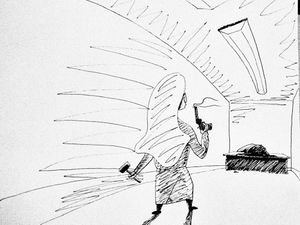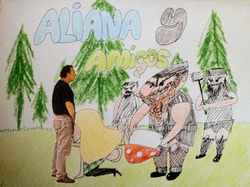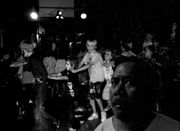Aliana y los enanitos grandes
Aliana y los enanitos grandes or Let's Squirrel! (US dub title) is an animated Spanish kids' TV show that ran 1963-1972, then 1974-76, then 1979-1992, then 1993-2007 on Televisión Española, and has been adapted into 31 feature films, including but not limited to 1971's Aliana come una galleta (dubbed for US release as The Mystery of Squirrel Tart), 1973's Aliana confia en el cosmonauta con los caramelos (dubbed for US release as Squirrels Out In Space), Aliana visita el templo (banned from US release because of alleged antisemitism), 1980's Aliana y el jamón serrano (released in the US as Squirrel Squirrel Squirrel, which is infamous for its subliminal phallic symbolism), Aliana salva todo el mundo de la combustión espontánea (1984) and A Aliana le encantan los huevos (2004).
The TV show came from a series of 3-minute short films following little girl Aliana in her various escapades, which were exhibited on various Spanish talk shows in the late 1950s and early 1960s, acclaimed by Spanish animation critic Rodrigo Smith as "very pointed and intelligent satires of Spanish politics. In Aliana se ata los cordones de los zapatos, for instance, the moment when Aliana ties her shoe laces is such a clever representation of the corrupt voting system." The franchise as a whole is regarded a classic throughout Spain and Latin America.
Aliana short films[edit | edit source]
The first Aliana short film, Aliana compra un martillo nuevo (1958), was created by animators Jorge Gomez and Alfonso Weiner, and was about a little girl going into a hardware shop to buy a new hammer. Gomez stated in later interviews that they had opposing visions: while Gomez wanted to make short films demonstrating the fun an innocent little girl can have performing banal tasks, Weiner, inspired by German expressionist films such as Die 3groschen Oper, wanted to make films of a darker nature; this shows in the first film's heavy use of film noir cinematography and the plot twist at the end in which Aliana pulls out her revolver and steals the hammer, only to then shoot the friendly hippopotamus behind the counter.
Gomez's and Weiner's ideas came together in the more cohesively directed Aliana coge el autobús (1959), in which Aliana gets on a bus and, as she gives her ticket to the driver, hastily injects him with a powerful sedative. Weiner stated he had originally intended to have her murder the driver with a switchblade, but that Gomez insisted that would be too dark for younger audiences. The film, thought to be a humorous take on how the consumer impedes the progress of public transport, struck a chord with Spaniards at the time, and was a massive success when it was aired on TV, with thousands of viewers writing in compliments.
First run 1963-1972[edit | edit source]
In Autumn of 1961, Televisión Española (TVE) commissioned a TV series of eight 30-minute episodes based on the by-now very popular Aliana shorts, with Jorge Gomez and Alfonso Weiner billed to direct. Gomez later said the two suffered significant writer's block when considering how their short satirical tales could be adapted into a singular immersive storyline. They produced a pilot, which was just Aliana mastica un chicle but slowed down 7x so as to accommodate the half-hour TV format, which was unpopular with test screenings and so TVE cancelled the show.
However everything changed when Alfonso Weiner was run over in a freak road accident on April 9th 1962. This occurred at 5:20pm in Peñagrande, a quiet northern suburb of Madrid. By a mysterious coincidence that would change the face of Spanish TV animation forever, the driver of the bulldozer that brutally mutilated and later killed Weiner was famous animator Julio Batres, who had admitted in interviews previous to the accidents that he was jealous of the Aliana shorts' success. After all charges were dropped in a short two month trial, TVE approached Batres to direct the new TV show, to which he responded apparently that he would only if he could direct by himself. TVE willingly obliged and fired Jorge Gomez.
Batres worked against a 7-month deadline to consolidate his ideas on how to adapt the Aliana shorts, when on 21st February, Spanish audiences were presented with Episode 1 Aliana y los enanitos grandes (literally Aliana and the Big Little Dwarves), which notably featured the addition of a gang of large old dwarves (who were voiced by little girls) whom Aliana, who now inhabits a quiet woodland, walks past every day to school and tries to avert their incessant witty cat-calling. Yet while the settings and characters in the TV show are barely comparable to the original shorts, the simple and mundane storylines remained. Episode 1 is entitled Aliana encuentra un gran árbol, whose small plot is expanded into a half-hour only because of the multiple rogue musical performances and product placements.
The show ran for 18 series (698 episodes) up until 1972, becoming the most popular show on Spanish TV at the time.
In 1971, director Julio Batres was involved in a high-profile child sex abuse case. On January 2nd, 1972, he was sentenced to 10 years in prison for the abuse of child voice actors who worked on Aliana y los enanitos grandes, which he continued to direct from his cell until a slew of viewer complaints came into TVE, forcing them to sack him by June that year. Batres directed 42 episodes in total from prison. As of this, TVE cancelled the show.
Aliana y los penes grandes[edit | edit source]
In 1973, Julio Batres was released on bail for good behaviour, but TVE refused to give him his job back, so he set to work on making a series of 20-minute pornographic films featuring Aliana, now dressed in a particularly scant schoolgirl outfit, on her many sexual encounters with different woodland creatures including the big dwarves, which Batres had the rights to as well as TVE, though more often than not with animated photographs of Batres himself. These films were exhibited in cinemas across Spain and were particularly popular with children, who were hit the hardest by the absence of Aliana y los enanitos grandes on national TV.
89 of these films have been found, but likely many more were produced between 1973 and 1974, as many of them were destroyed when Batres was accused of spreading child pornography in 1992.
Second run 1974-1976[edit | edit source]
TVE, believing that the public had by then forgiven and forgotten, and disgusted not by the pornos Batres was producing themselves but by the thought that they could be making all of that money instead, commissioned a new series from Batres. TVE got back all the same cast for the new season, even though half of it was undertaking therapy.
In November 1976 this had to be cancelled too as Batres was found guilty of sexually abusing the exact same cast members as he had been doing so in the early 1970s. Three series were made in total in this incarnation of the show.
English-language dubs[edit | edit source]
In September 1976, MGM bought the royalties to the entire Aliana y los enanitos grandes archive, and Spanish producer Carlos Fredrera supervised the production of the dubs and released them on US TV. Fedrera was said to at this time have poor English: according to English Aliana voice-actor Kim Jones, he "scarcely knew any other word than 'squirrel', a word which he for whatever reason found absolutely hilarious, and insisted on putting it in the title of the show. Because of this we had to shoot new sequences with squirrel characters in them so that the title would make sense. Sometimes this meant shooting colour scenes to put into the older episodes which were in black and white." MGM lost the rights in 1984, just prior to the release of disaster epic Aliana salva todo el mundo de la combustión espontánea as Spanish broadcasters and producers feared its plot would be compromised by a dub.
When Fedrera died in 1996, a 1-hour tribute episode was made for US TV with a plot that solely involved the squirrel characters he was famous for making happen.
Third run 1979-1992[edit | edit source]
Although Julio Batres was released on bail in early 1977, he felt as though the Spanish public would not trust him to direct the show anymore, even though TVE summoned him to do so. Instead he moved to London and ingratiated himself with many of the big names in light entertainment at the time. He also became an important member of the UK's growing clubbing scene.
When he finally returned to Spain in 1979 he received a hero's welcome; millions gathered to watch as he got off the plane, La Sección Nacional de Flamenco organised a palm-waving procession for him, mothers stood in a great line for him to bless and kiss their babies (they would later realise this was a great mistake), and there was a 21-gun salute. He had been commissioned to produce what would become the most famous and defining run of the show yet.
Batres made major changes, which has been claimed to have facilitated the show's new-found success. First, he decided that he was not happy with the majority of the cast, and replaced all but some of the voices of the dwarves with new young talent. Second, he decided that the show would be more interesting with a new dynamic; and so throughout this run of the show the big dwarves transport by elevated penny-farthings that shoot blue fire out of their exhaust pipes, Aliana carries a bright green extendable radio antenna that she uses to solve rudimentary mathematical problems, and the forest is cut-down to make way for a space city, said to be modelled on Newport; tropes common in Spanish sci-fi films of the time. In the early '80s the character Enrique el corridor malévolo de vacíos (English: either "Henry the malevolent void-runner" or "Henry the evil empty corridor"; both apply in this case), a futuristic Nazi aircraft carrier who eventually befriends Aliana, appears in 26 episodes, only to be pulled completely because of statistics showing that Soviet aircraft carriers were more popular with the Spanish youth.
After a record-breaking 14 years on this run, Batres was interrupted by historic allegations of producing child pornography.




